Digital Marketing for Healthcare to Boost Patient Engagement

In the past, patients typically picked doctors based on recommendations from acquaintances, but today, they increasingly turn to the web to find information about healthcare options. Online marketing for clinics involves promoting medical services through the Internet.
A medical center may have the latest cutting-edge technology and the best doctors, but if no one knows about it, you will most likely be at a loss. How can marketing help? Proper marketing includes promoting medical services, practices, or products through diverse channels such as content creation, social media, or email campaigns. Its goal is to connect with patients, enhance brand visibility, and build trust.
Why is proper medical digital marketing so important? In a few words, it helps clinics and health systems grow and connect with current and future patients. Digital health marketing helps engage more patients and retain them.
Let's talk more about the "kitchen" of digital marketing for the healthcare sector.
Healthcare digital marketing: why it is important
Nowadays, healthcare providers need to leverage digital marketing techniques to engage with patients and differentiate themselves in a crowded market. Verified Market Research predicts the global healthcare market growth. It will achieve $665.37 billion by 2028. Healthcare digital marketing blends advanced technology with targeted communication to enhance patient interaction, foster business growth, and improve care delivery.
Below, we will consider the advantages and trends in healthcare Internet marketing and discover contrasts between digital and traditional marketing within the healthcare sector.
Why choose digital marketing for healthcare providers
Digital marketing offers plenty of top advantages for healthcare providers. There are just some of them:
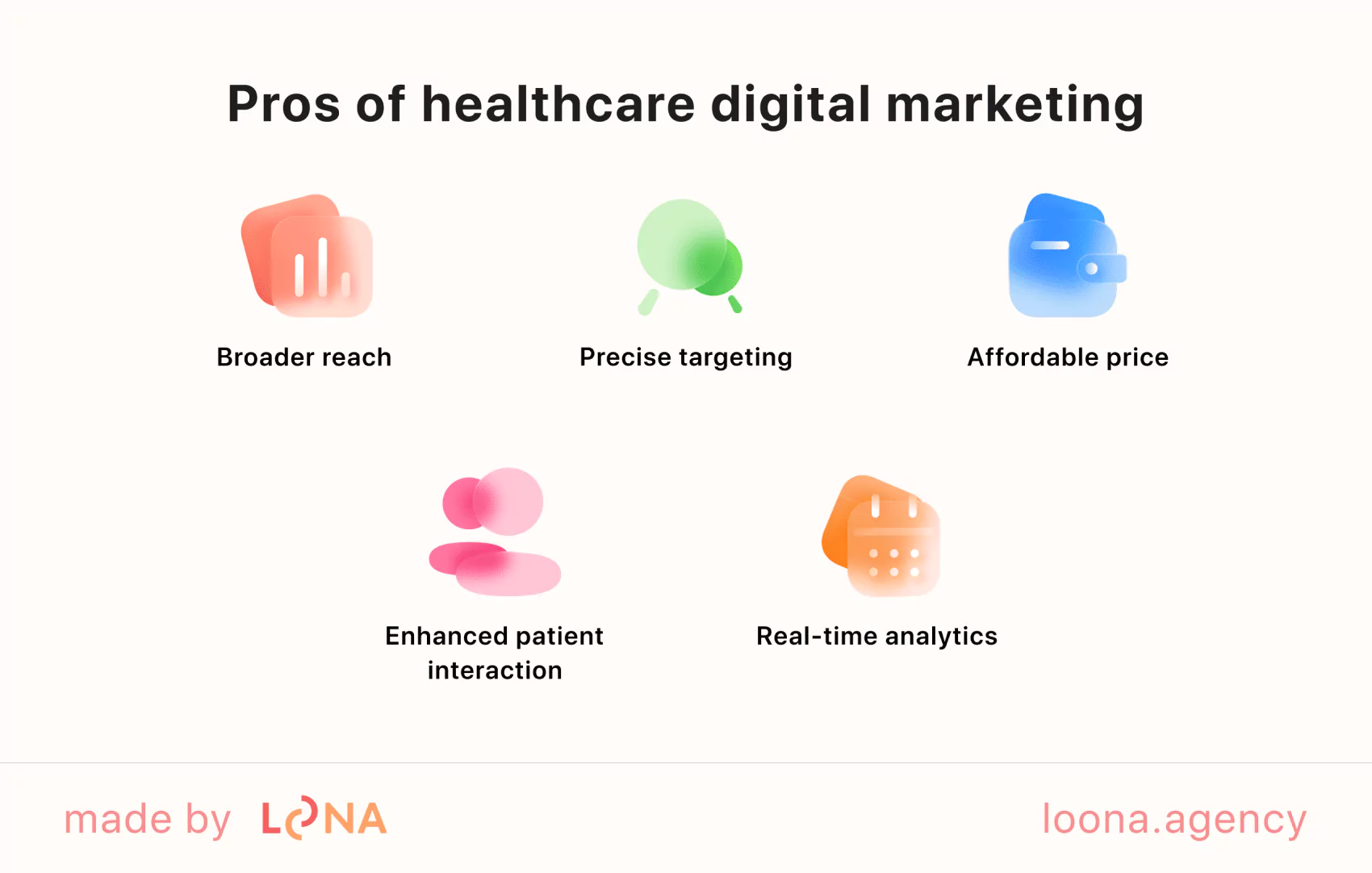
Broader reach: Healthcare businesses can engage a wider audience through various online platforms.
Precise targeting: With the help of digital marketing for healthcare providers, you can deliver tailored messages to specific patient groups using data insights.
Affordable price: It is a cost-effective way compared to traditional advertising like print or TV campaigns or ads on billboards.
Enhanced patient interaction: Marketing for healthcare fosters stronger relationships with patients through content and social media channels.
Real-time analytics: There are powerful medical digital marketing analytics tools. With them, you can monitor campaign performance and make adjustments based on immediate feedback.
The modern world requires keeping up with it. The answer to why digital marketing has such a big advantage over traditional marketing is obvious.
Read also: E-E-A-T Explained: Boost Your Website's Trust and Authority
Digital healthcare marketing vs traditional marketing
Online and traditional marketing represent two different strategies for promoting products and services. Traditional marketing focuses on various offline channels. These can be TV, print media, or billboards. Digital marketing is about using online platforms such as email, social media, or search engine rankings.
Of course, choosing digital marketing for hospitals or any other healthcare organization brings you much closer to success.
Aspect | Digital marketing | Traditional marketing (TV, print, billboards) |
Cost | More affordable and scalable based on budget | Usually higher costs, such as for TV, print, and billboards |
Engagement | Interactive with direct communication and measurable results | Limited engagement, mostly one-way communication (people see and move on) |
Targeting | Precise targeting using data and analytics | Broad targeting, less specific |
Interaction with audience | Enables two-way communication and feedback (feedback is our all!) | Mostly passive, with limited audience feedback |
Lifespan | It is possible to create a long-lasting online presence and campaigns | Campaigns generally have a shorter lifespan |
Healthcare digital marketing trends in 2025
The healthcare sector is adopting several important digital marketing trends:
Artificial intelligence is a new reality: Leveraging artificial intelligence (AI) to create personalized patient experiences, promoting telemedicine services, and optimizing for voice search.
Social media popularity continues to grow: Social media is playing a larger role in direct patient engagement, while video content and patient testimonials are strengthening trust.
Privacy-first marketing: There is a growing emphasis on The Health Insurance Portability and Accountability Act (HIPAA)-adapted email marketing. You will learn more about this Act in our guide a little later.
Local search optimization: This involves optimizing healthcare practices for local SEO (search engine optimization) to improve search visibility and attract patients in specific geographic areas.
Now, let’s discover how to create a powerful marketing strategy that will engage and retain your target audience.
Main steps to craft a marketing strategy for healthcare field
Building a successful healthcare online marketing strategy requires a structured approach to ensure that your goals are achieved and your target audience is effectively reached. This is where we will begin.
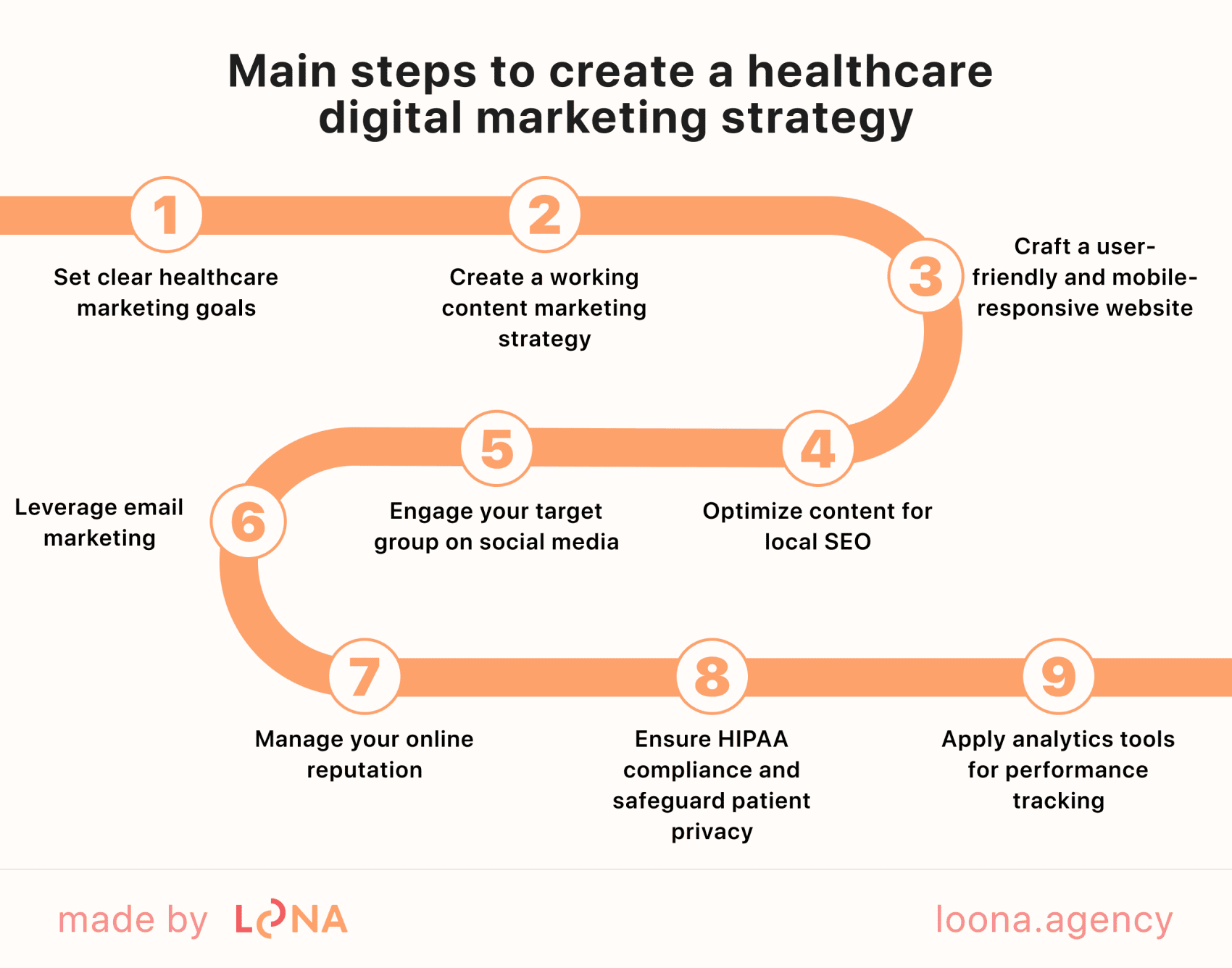
Step 1: Set clear healthcare marketing goals
Start by determining your primary goals. Want to increase patient visits, raise awareness for a new service, or educate the public on health issues? In any case, having defined objectives helps guide your marketing efforts and ensures they align with your healthcare practice’s growth.
Identify your target audience
Pinpointing your ideal patient demographic is essential for crafting effective campaigns. Consider factors such as location, age, medical needs, and lifestyle. Thus, you can tailor your healthcare digital strategy to meet the specific concerns of your clients and be adapted to their interests.
Age: Identify the age groups that most commonly seek your services. They can be children, adults, or elderly individuals. Pay attention to the fact that each demographic may have distinct healthcare requirements.
Gender: Certain healthcare services are more relevant to specific genders, such as gynecology for women or urology for men. So, target your audience accordingly.
Location: Understand the geographic areas where you provide your services. Localized marketing efforts can help you connect with patients in nearby regions more effectively.
Income and education level: Specific medical services may appeal to particular income groups or educational levels. For example, advanced treatments might attract higher-income individuals. Basic care might appeal to other groups.
Health needs and concerns: Find out prevalent medical issues or conditions among your target audience, like diabetes, pregnancy, or mental health, to refine your approach.
Values and lifestyle: Take into account your patients' values and lifestyle choices. These can be preferences for natural or alternative therapies, tech-savvy health solutions, or family-focused healthcare.
Tip for you: use previous patient records
Review your current patient data to spot patterns in demographics and healthcare needs. Analyze this information to guide your marketing efforts and health service offerings more effectively.
Establish concrete and trackable goals
Set specific, measurable goals. This will help to evaluate your marketing success. These may include targets like website visits, new patient appointments, or social media interactions. It is vital to apply key performance indicators (KPIs) to assess your campaigns. Tracking KPIs will also help you to make data-driven decisions to enhance your marketing strategy.
The main KPIs for your healthcare digital marketing strategy include:
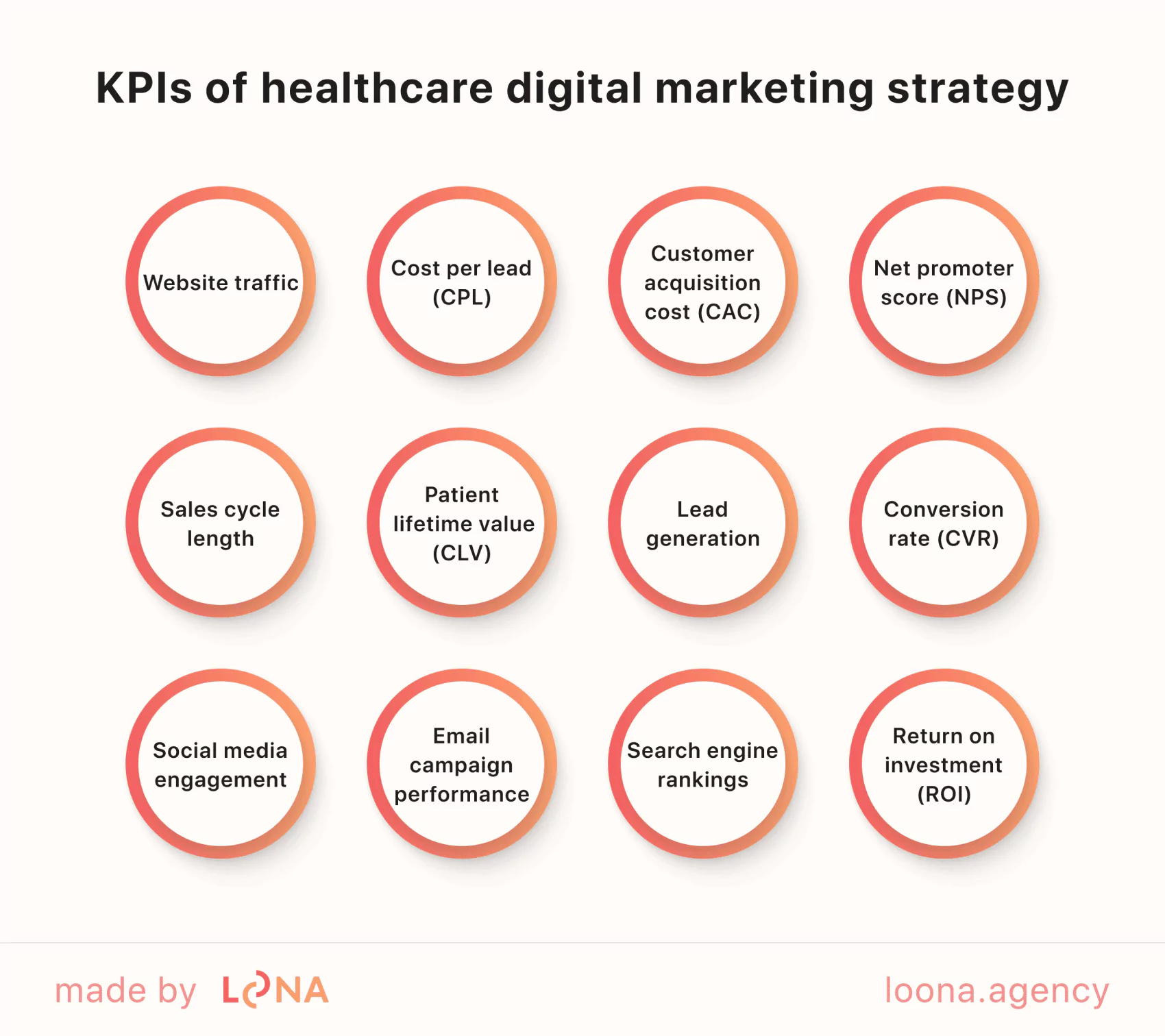
Website traffic
Tracking the volume of visitors to your website helps assess how effectively people are finding and engaging with your content. It’s important to analyze the sources of traffic, such as paid campaigns, organic searches, and social media. You should identify which channels are driving the most visitors.
Cost per lead (CPL)
The CPL metric measures the expense of engaging a potential patient. In healthcare, a typical CPL ranges from $26 to $50, with leading organizations achieving around $30. A lower CPL indicates more efficient marketing efforts. This helps drive website traffic and generate leads at a cost-effective rate.
Customer acquisition cost (CAC)
It tracks the total price you pay to engage a new patient. This cost includes marketing and sales expenses. In healthcare, the average CAC is between $300 and $1,000. A lower CAC compared to the patient's lifetime value indicates effective medical website marketing. Great, you are in the right direction!
Net promoter score (NPS)
You need to consider this vital metric that measures patient satisfaction and loyalty. The index is based on the likelihood of patients recommending your healthcare services. An NPS of 70-80% is typical in healthcare. This rate indicates strong patient satisfaction and potential for organic growth through referrals.
Sales cycle length
The sales cycle in healthcare is typically longer, averaging 6–12 months, due to the thorough decision-making process patients undergo. Effective lead nurturing and communication are essential to shorten this cycle and convert prospects into patients.
Patient lifetime value (CLV)
The metric estimates the total revenue gained from a patient over their full relationship part of time with your organization. On average, a patient’s CLV is between $10,000 and $20,000, making it vital for healthcare providers to focus on long-term patient retention.
Lead generation
This metric refers to gathering information from individuals interested in your healthcare services, such as through form submissions or inquiries. Tracking this KPI helps assess how well your site and marketing tactics are turning visitors into potential patients.
Conversion rate (CVR)
The metric measures the number of your leads that convert into patients. A high conversion rate proves that your website effectively encourages users to take the next steps.
Social media engagement
Social media marketing in healthcare industry is a very powerful tool to engage more clients. Metrics like likes, comments, shares, and new followers on platforms like Facebook, Instagram, and Twitter reflect how effectively your content is connecting with your audience. High engagement rates mean your content is actual and fostering relationships with your community.
Email campaign performance
These KPIs, including open rates, click-through rates (CTR), and conversion rates, help gauge how successful your email campaigns are in capturing attention and driving recipients to take action. These actions may include scheduling appointments or learning more about your services.
Search engine rankings
Tracking your website’s Google position for key search terms related to healthcare services is crucial for assessing the performance of your technical SEO efforts. Higher rankings enhance the visibility of your platform. This leads to more traffic and more potential patients.
Return on investment (ROI)
You need this metric to measure the financial returns obtained from marketing activities compared to the costs. It provides insight into whether your marketing efforts are financially viable. You will also understand whether your investments are yielding profitable outcomes.
Below, you will learn how to improve all these metrics with appropriate strategies.
Step 2: Create a working content marketing strategy
Building an effective content marketing strategy is essential for engaging with patients and establishing your healthcare services as a trusted brand.
Assess your current content (try to be objective)
Where can you start to create successful digital marketing for hospital strategy? Begin by analyzing the content you already have across your platforms.
Analyze your blog, socials, and other channels. Evaluate content’s performance using metrics like views, engagement rates, and user feedback. This will help you identify successful content cases and determine which areas need updating or enhancements.
Create high-quality content in various formats
Focus on producing content that solves the issues and concerns of your patients. Diversify your content by offering blog posts, videos, podcasts, infographics, and patient testimonials to engage a wider audience.
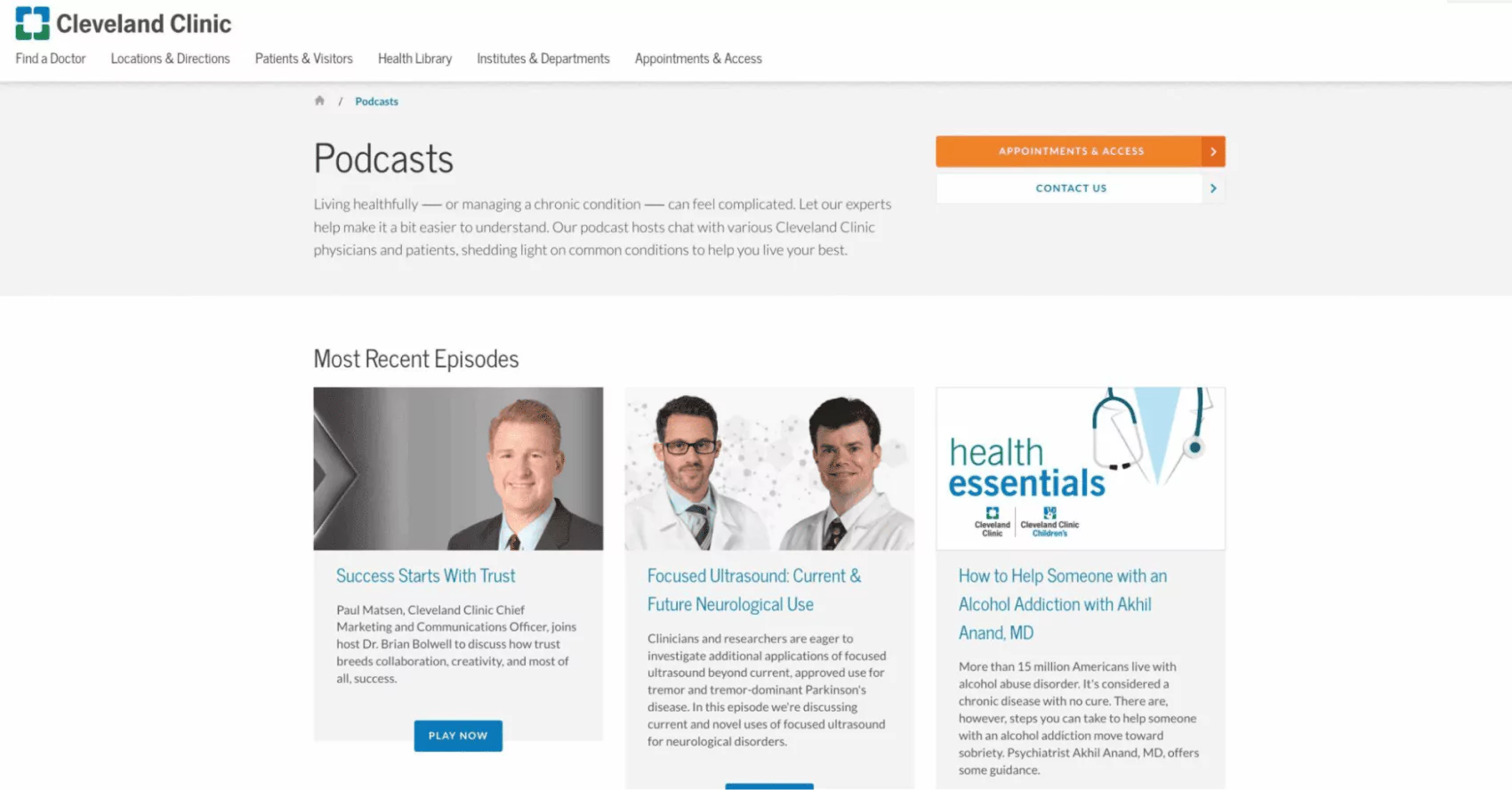
Create valuable resources like health tips, educational guides, and success stories. These resources should resonate with your target audience’s issues and interests. Ensure your content is clear, informative, and accessible to your target demographic. This will impact the success of your efforts in digital marketing for healthcare professionals.
Apply SEO best practices
To maximize the reach of your content, implement SEO strategies that help your material rank higher in search engine results. Use keyword research to discover relevant search terms patients apply and update your content accordingly.
Pay attention to on-page SEO elements like headings, meta descriptions, and image alt text, and consider off-page tactics such as acquiring quality backlinks to boost visibility further. Your content should be both search-engine-optimized and user-friendly. This will help you to increase its effectiveness.
Step 3: Craft a user-friendly and mobile-responsive website
Your site is like a presentation of your brand. A well-crafted website is important for building an effective digital marketing strategy for healthcare, offering both functionality and ease of use.
Ensure mobile compatibility
With the rising use of mobile phones for healthcare searches, your website must be mobile-optimized. A responsive design adjusts to different types of screen sizes. Users should easily navigate your site. Doesn’t matter whether they're using a tablet, phone, or desktop device. Mobile optimization is crucial for both SEO rankings and user experience.
Optimize website speed and performance
Website loading times can significantly influence user engagement and conversions. Slow pages to drive visitors away and reduce conversion rates. To improve site performance, focus on optimizing images, reducing code bloat, and using content delivery networks (CDNs) for faster access. Try not to overwhelm your website with digital healthcare advertising. Regular performance checks help maintain speed and reliability.
Prioritize web accessibility
Accessibility is an indicator of the right digital health marketing, which means that your online platform is usable by all individuals. People with disabilities should also use your site freely. You can add such functions as keyboard navigation or alternative text for images. Provide compatibility with screen readers to meet accessibility standards. Following the WCAG (Web Content Accessibility Guidelines) ensures inclusivity for all patients.
Step 4: Optimize content for local SEO
Why should SEO be local?
According to Think with Google, searches for "open near me" have enhanced by 400%. Additionally, mobile queries combining "near me" with "where to buy" saw an increase of over 200% over a two-year period, highlighting the growing importance of local search optimization for businesses.
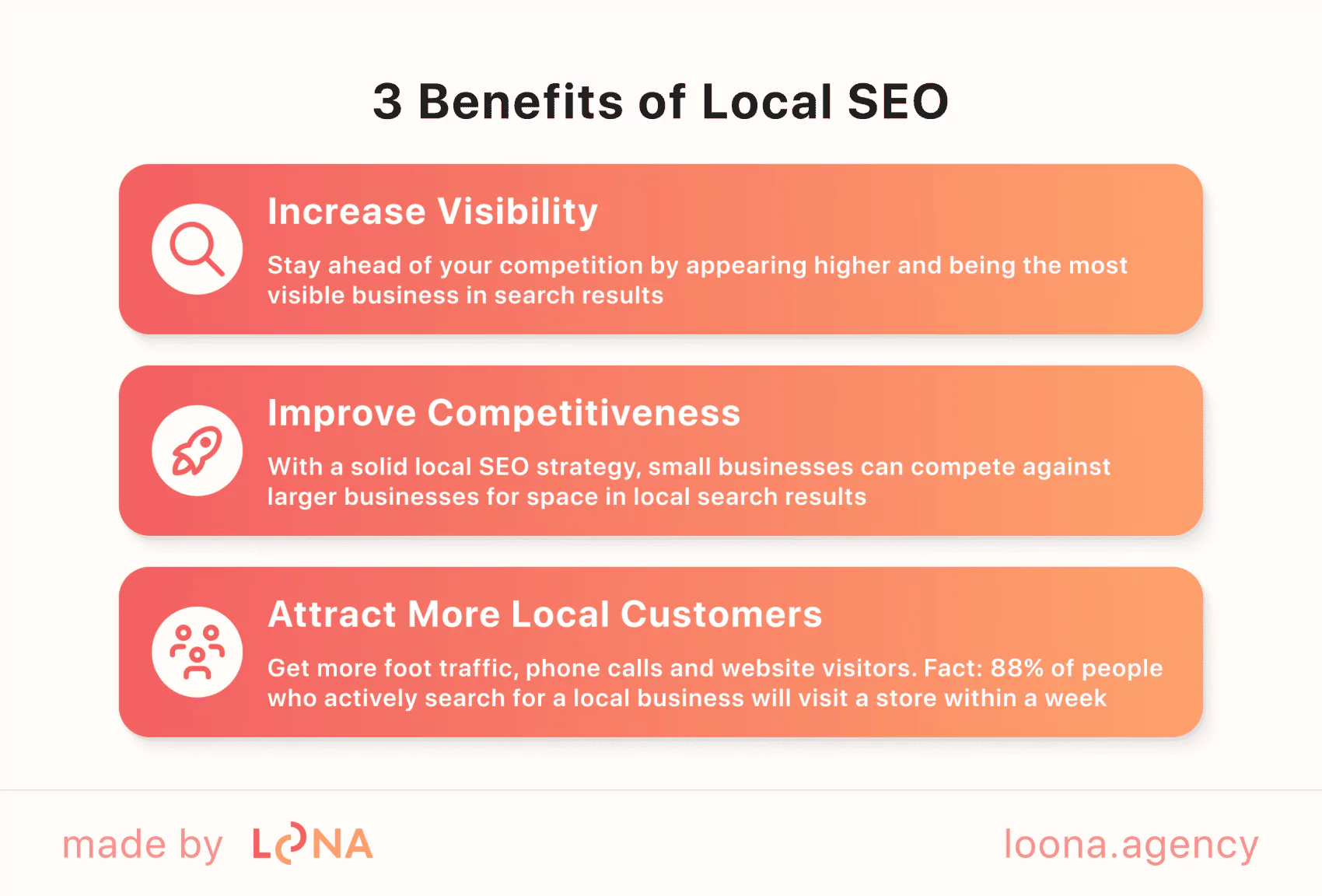
Upgrade your Google Business Profile
To boost your local search presence, begin by fine-tuning your GBP (Google Business Profile). Ensure that all basic information, such as your phone number, company address, and working hours, is correct. Keep your profile fresh by regularly adding relevant photos, updates, and patient testimonials. These elements are vital for improving local rankings and gaining customer trust.
Improve local SEO on your website
For successful localized on-page SEO, your website needs to be tailored for location-specific searches. Integrate keywords that are relevant to your geographic area and optimize meta tags, headers, and content to reflect local terms. It can be challenging, but at Loona digital health marketing agency, we can help you with this task.
Acquiring local backlinks and creating dedicated landing pages for different locations can strengthen your website's authority in local search results.
By improving your local SEO strategy, you can drive more traffic to your site. You will attract potential patients who are looking for healthcare services nearby.
Step 5: Engage your target group on social media
Social media provides a great opportunity for healthcare providers to gain visibility, engage directly with patients, obtaining their fair feedback.
Pick the best social media platforms
Focus on online platforms where your target group is most active. For healthcare professionals, sites like Instagram, Facebook, and LinkedIn are great options. Choose platforms based on the interests and habits of your patient base.
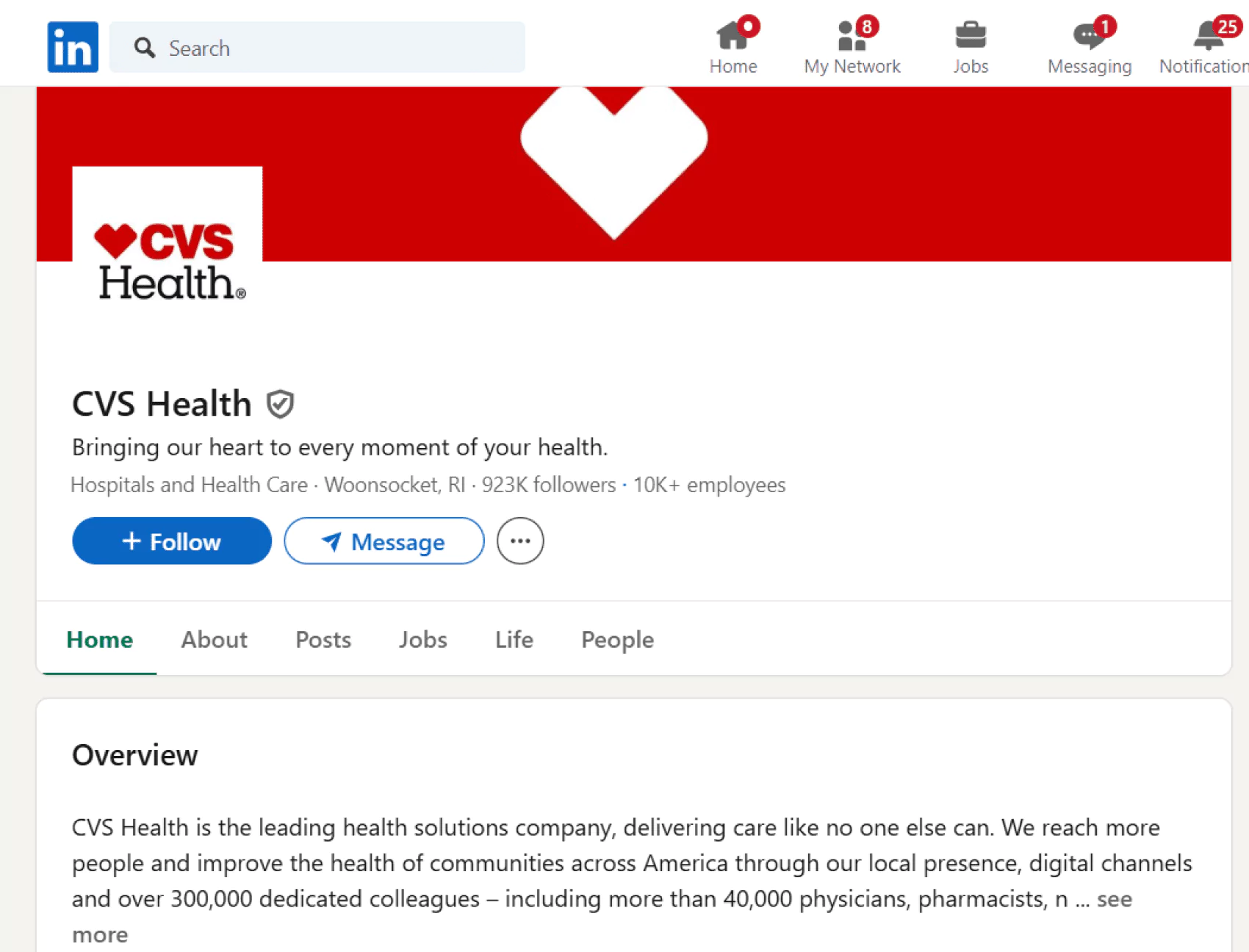
Share valuable and relevant content
Post content that captures the interest of your audience, such as health advice, patient success stories, updates on services, or insights into your clinic. You can attract more followers by producing useful, engaging, informative content. Also, you will position your brand as a credible source of healthcare information.
Encourage engagement and interaction
Promote engagement by initiating conversations and running polls. Try to reply to comments and messages quickly. This helps you build stronger relationships with patients, develops a sense of community, and enhances your online visibility. Actively engaging with your followers shows them that you care about their concerns and are accessible for their healthcare needs.
Step 6: Leverage email marketing
Apart from SEO, email marketing is a powerful method for maintaining patient engagement and building long-term relationships. By delivering relevant content at the right time, healthcare providers can keep patients informed and prompt them to take action.
Below, we included tips to help you make the most of healthcare email marketing:
Build and segment your email list
Begin by gathering email addresses through website sign-ups, patient forms, or newsletter subscriptions. Always ensure consent before sending communications.
Once you have a list, you should segment it depending on such criteria as demographics of your patients, their preferences, or medical history. This lets you send highly relevant and adapted messages to each group, boosting engagement.
Create personalized and focused email campaigns
Personalization can greatly improve the effectiveness of your marketing email campaigns. Address patients by name, reference their specific healthcare needs, or suggest content tailored to their treatment or interests.
Whether it's sending appointment reminders, health advice, or newsletters, make sure the content aligns with their unique needs. Targeted emails foster stronger patient relationships, higher appointment rates, and increased loyalty.
Here’s an example of an effective footer subscriber form from Michigan Dental. The design is clean and straightforward. It has a clear value proposition outlining what subscribers can expect to receive— the latest updates on dental health news.
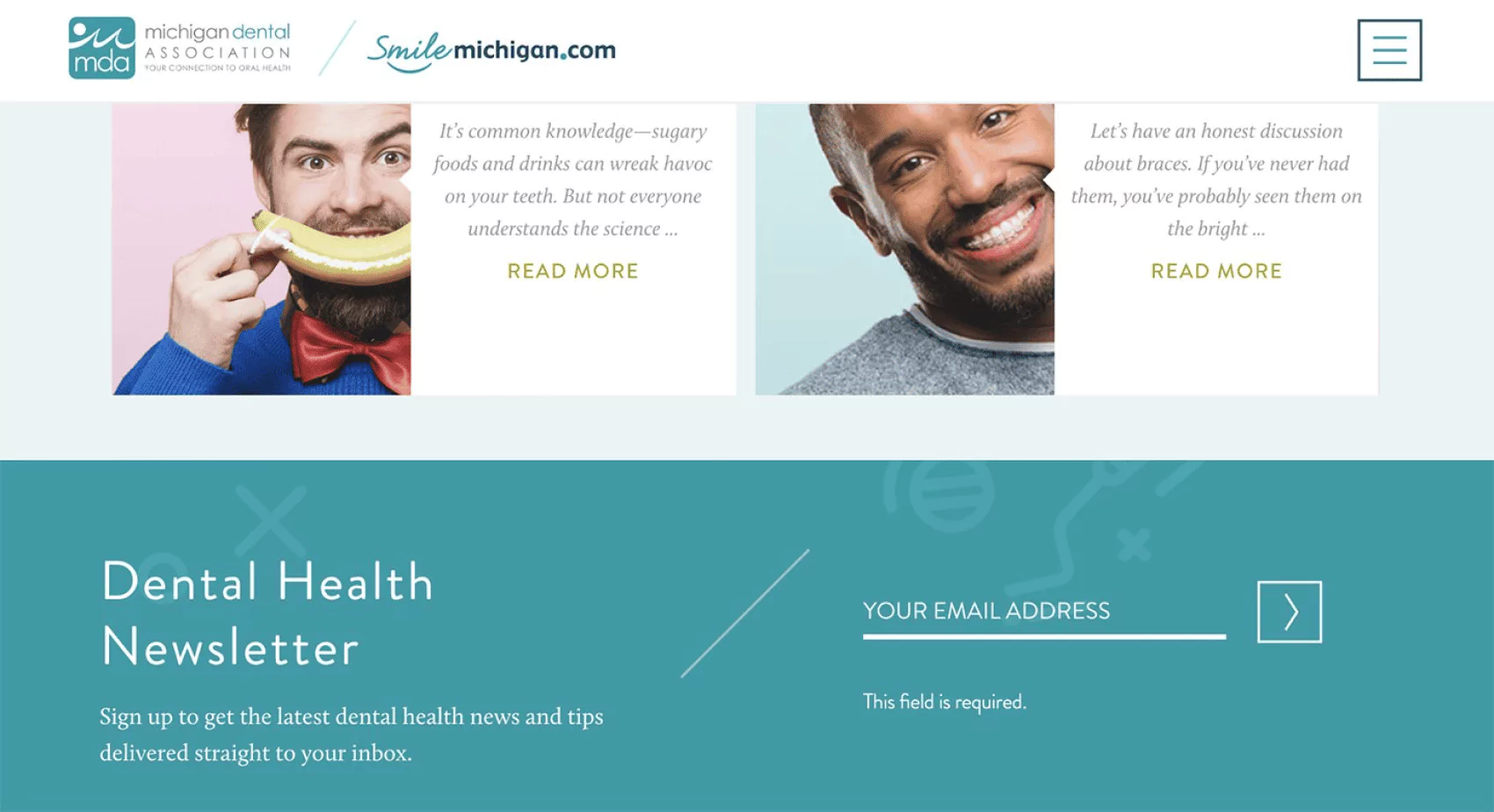
Step 7: Manage your online reputation
Your online reputation builds customer trust. Actively managing your online presence can help attract potential patients, address concerns promptly, and enhance your credibility in the industry. So, how do you create a positive brand image and strong reputation?
Monitor and respond to reviews and feedback
It's vital to keep an eye on reviews and feedback from your customers across diverse online platforms such as Google, Facebook, Healthgrades, or Yelp. You should regularly check these sites. It is essential to handle both positive and negative reviews promptly and maintain direct contact with patients.
When responding, always remain courteous, empathetic, and solution-oriented. It is especially important when solving complaints. Do you know that if you handle feedback correctly, you can turn a dissatisfied patient into a loyal one? You will also demonstrate your commitment to excellent care and patient satisfaction.
For example, Cleveland Clinic is a great example of how to transform unhappy patients into loyal ones. The clinic did it by carefully addressing their concerns. After receiving feedback about poor communication, the clinic enhanced staff training. They ensured quicker updates and launched a "Patient Advocate" program to resolve issues on the spot.
They also made a point to follow up with patients after addressing their complaints. The clients’ issues were resolved. The result? Greater patient loyalty and positive referrals.
Showcase your successful case studies and testimonials
It is also a vital step in building the proper digital marketing for hospitals. Regularly enhance and update your site and social media channels with new content. The content should highlight your expertise and success stories. Share helpful health tips, patient testimonials, and practice updates to showcase your knowledge.
Your business profiles should be accurate and up-to-date, especially on review sites. This reinforces trust. A well-managed online reputation engages new patients and improves relationships with those you have as regular customers.
Read also: Top 10 SEO Agencies for Small Businesses in 2025
Step 8: Ensure HIPAA compliance and safeguard patient privacy
Safeguarding patient privacy and adhering to legal standards is crucial. HIPAA establishes strict guidelines to protect private patient information. Following HIPAA regulations is not only a legal obligation but also a necessity for maintaining patient trust.
What are HIPAA guidelines?HIPAA sets clear rules for managing patient data, including personal health details, medical records, and any identifiable information.
Healthcare marketers need to familiarize themselves with these rules, especially when dealing with email communications, online patient interactions, and marketing campaigns. Any content that involves patient data must be handled securely and in line with HIPAA standards.
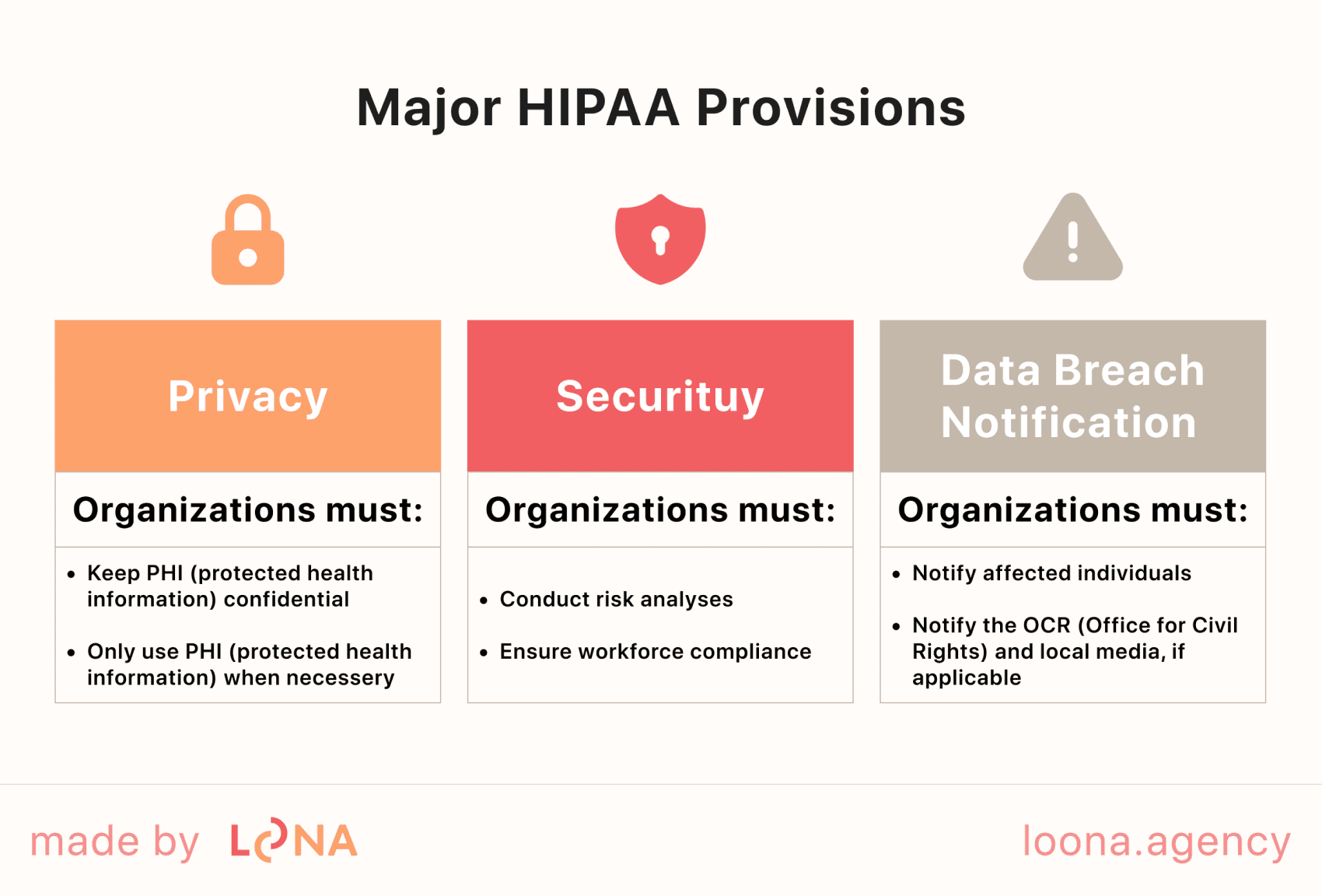
Ensure secure communication channels
When utilizing digital platforms for communication or marketing, always employ HIPAA-compliant tools for transmitting patient data. Encrypted email services or secure patient portals should be used when discussing sensitive medical information. Avoid using regular email or social media to convey private health-related details.
Provide HIPAA training for your team
It’s important to educate your marketing team, healthcare providers, and other staff members about HIPAA regulations. Training your staff regularly on these protocols can prevent unintentional breaches. All team members should understand the importance of patient privacy in every aspect of hospital digital marketing.
Create HIPAA-compliant content
All marketing materials—whether emails, blogs, social media posts, or newsletters—should comply with HIPAA privacy standards. You can’t share any PHI (personal health information) unless you have explicit consent from the patient. We recommend focusing on general healthcare tips and anonymized patient success stories. This will help to maintain privacy while still delivering valuable content.
Step 9: Apply analytics tools for performance tracking
To assess the success of your healthcare Internet marketing efforts, apply analytics tools to monitor key performance indicators. These tools are important to use to get valuable insights that can influence your decisions. Based on these insights, you can improve your approach and optimize results.
Let’s consider how to integrate analytics into your marketing strategy effectively:
Select the right analytics tools
Several tools can help you monitor the performance of your healthcare marketing campaigns. So you can improve your efforts based on results. Below, we added some of the most popular and working analytics tools:
Google Analytics:Google Analytics tracks website traffic, user engagement, conversion rates, and other important metrics, helping you understand how visitors interact with your site.
Google Search Console: Ideal for monitoring SEO performance, it provides insights into how your online platform ranks on search engines and which keywords drive traffic.
Social Media Analytics: Platforms like Facebook Insights, Instagram Analytics, and Twitter Analytics give data on user engagement, reach, and demographics, helping you understand audience behavior on social media.
HubSpot: It is a popular, feature-rich inbound marketing platform with great tools for analyzing email campaigns, content performance, and lead generation.
Sprout Social: A social media management tool that offers in-depth analytics on audience growth, patient engagement, and content performance across diverse platforms.
Semrush: A tool for tracking SEO content, and SEM (search engine marketing) performance, allowing you to monitor keyword rankings, backlinks, and overall site state.
By using these analytics tools, focus on specific KPIs that are important for reaching your marketing goals. These may include conversion rates, website traffic, search engine rankings, email campaign performance, and others.
Analyze and act on insights
Once you have gathered data, you need to analyze it for trends and actionable insights. For example, if you identify a high bounce rate, it might indicate that your website’s user experience needs updates. Similarly, low social media engagement could suggest a need to turn to Loona, a marketing healthcare digital agency, to improve your content strategy.
Read also: The Power of SEM Tools for Digital Marketing
Optimize continuously
Regularly reviewing analytics helps identify fields that require improvement and changes in your marketing tactics. Testing different strategies, tracking trends over time, and making adjustments based on data will allow you to optimize your healthcare marketing efforts for ongoing success.
By utilizing analytics tools and monitoring your marketing performance, healthcare providers can make data-driven decisions, adjust campaigns as needed, and achieve continuous improvements that lead to better patient engagement and marketing outcomes.
Conclusion
Digital marketing for healthcare industry is a need for healthcare providers aiming to build stronger connections with patients and boost their online presence. By setting precise goals, developing compelling content, and optimizing for mobile and local search, healthcare practices can increase visibility and engagement.
Social media, email campaigns, and reputation management help foster deeper patient relationships. Prioritizing HIPAA compliance and utilizing analytics ensures ongoing refinement of marketing strategies. And we have already told you about all of this in our healthcare marketing guide.
Follow the approaches we mentioned in this brief to maximize your marketing success and achieve improved patient outcomes. If you need help, you can contact us and order our top digital marketing services to let your business develop in the healthcare sector. As one of the best healthcare digital marketing agencies, we know how to make your project shine!
Review our portfolio to see how we helped businesses across various industries thrive!






